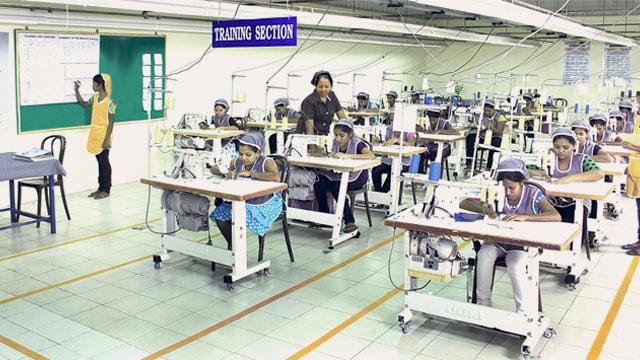“Scientific training can be defined as an art that allows transmitting to the operators, valid experiences, rational methods of work with right specifications matured through repeated research and practical experimentations achieved after many years of hard work,” says Francesco Bellino, Apparel Manufacturing Specialist, elucidating the importance of scientific training and its achievable outcomes.
 The training of the human resources in apparel industry is one of the most important and demanding tasks for the company’s management. At the time of opening of the new units, usually the training is organized in a training centre which is always located in a predefined dedicated space inside the structure, following specific methods and manuals. However to maintain the quality of the product and its knowledge processing, it is important that once the unit is in operation, the training of the operators at the centre should immediately stop. This is because at this stage no operator needs to be retrained using these scientific methods again as they have already absorbed and gained knowledge. In addition, the company sustains a heavy cost on training too if it continues to do so. The new operators and staff should be trained directly in the production line.
The training of the human resources in apparel industry is one of the most important and demanding tasks for the company’s management. At the time of opening of the new units, usually the training is organized in a training centre which is always located in a predefined dedicated space inside the structure, following specific methods and manuals. However to maintain the quality of the product and its knowledge processing, it is important that once the unit is in operation, the training of the operators at the centre should immediately stop. This is because at this stage no operator needs to be retrained using these scientific methods again as they have already absorbed and gained knowledge. In addition, the company sustains a heavy cost on training too if it continues to do so. The new operators and staff should be trained directly in the production line.
Francesco Bellino, a tailoring expert with 16 years of experience within textile and clothing industries, has achieved good results for quality and improving productivity. He reorganized the factories and put an effective quality and productivity improvement plan into practice. The most part of his career was spent with ICA srl Napoli, Italy and IN.CO.TEX SPA, Mira (VE), Italy producing high-end brands.
The training centre should now be closed down because according to the management plan, the allotted time dedicated to the same is over. Nobody needs to be trained or re-trained further with this scientific method. In the future all new operators and staff may be trained directly in the production line.
Certainly the training centre is an added cost to the organization, but in my opinion it represents a necessary investment in the following cases:
- Fashion companies which utilize difficult and delicate fabrics or follow methods which are usually specific but unusual, and produce high quality garments;
- Companies which adopt modular production systems where skilled operators have to make different operations in the same task; and
- Companies located in suburban areas have to select and then train operators for not less than six months.
In the above listed cases, the companies first go for selecting the right resources and then taking them through the Training Department and start training them.
The energies and the expenses sustained would be largely compensated by saving on manpower, improving the quality of the product, more production and better maintenance and utilization of machineries and equipments.
The following objectives can be achieved through a proper training:
- Help the operators to quickly reach the production standard;
- Increase the qualitative level of the products;
- Reduce the number of accidents (both to the people and the machineries);
- Reduce the machineries and equipments breakdown time; and
- Assure the fidelity and the continuity of execution of the method reached by the Technical and Methods Department.
Companies usually let operators learn a new work by following methods:
- To learn a new work by himself – This is a dangerous and a risky learning method because the operator is not able to understand the new work and the rules thereof to follow. He soon gets discouraged and demotivated.
- To learn by observing an experienced operator – Learning by observing the experienced operator meets with notable difficulties. The latter often feels jealous, shows a feeling of incapability to teach, is uncooperative most of the time and shows signs of annoyance.
- To learn with the help of a specialized instructor – This is the best method since the operator here is helped in his assignment by an experienced person, both in the execution of the work and in following a scientific way to teaching too.
To maintain the quality of the product and its knowledge processing, it is important that once the unit is in operation, the training of the operators at the centre should immediately stop, avoiding an added cost to the organization
It helps the operators learn all the correct motions according to the rational and the operational sequences established by the Time and Method Department. All the errors are immediately pointed out and rectified; and in future the operator is able to eliminate them.
The main steps to follow for effective operators training
1) Understand the job and personally perform it
Before teaching a new job the supervisor has to interpret and do the job himself in a way as is established by the Technical Department in full respect of the set method of the established operational sequence and allotted standard time. The instructor will be able to teach the correct method if he himself is able to understand and perform it first.
[bleft]Today companies must understand the importance of the scientific training and for that one has to devote an imposing effort in this field. Training should offer the potential to reduce waste, improve productivity, reduce cost, and increase profitability. The success of any organization is linked to its ability to manage the knowledge and competencies of its employees.[/bleft]
2) Divide the work in homogeneous learning movements by –
a) Learning the more difficult movements;
b) Improving the execution of movements;
c) Memorizing the movements; and
d) Memorizing the whole operational sequence.
3) Understand the work quality needed
The supervisor has to identify the work quality points and transmit it to the operator in the full respect of the standards established by the Company Quality Policy or customer’s samples.
4) Collect information about the operator to train
Every individual reacts differently to training. It can bring good results only if the supervisor collects all the possible information about the operator’s character, attitudes and above all on his previous job experiences.
5) Establish a first cordial contact with the operator
If the new operator to be trained comes from outside, or from another department of the same company, it is essential to welcome him with pleasantries, to show him the work developed in the department, to encourage him to speak and listen to his exposures. It is necessary to establish a relation based on trust that facilitates the following training.
6) Show to the operator all the details as to how the machineries and equipments work
To allow the operator to perform a good work, it is required that he should have a good knowledge of the machineries and equipments he has to work upon. The operator should wear clothes in synchronization with safety norms to avoid accidents or spoiling equipments.
7) Explain and illustrate the operation details to perform
The supervisor has to explain to the operator, the work that he has to perform, operation by operation, movement by movement with all the details. He needs to insist on the most difficult step of the work with patience and has to get quality and precision first and the operator speed will follow next.
8) Let the operator try the job
During the training, period the operator has to perform the work as speedily as possible; he has to get accustomed to the movements of the operation in the specified order to memorize the operational sequence so that he doesn’t think while performing the job. The entire operation sequence should form a part of the reflex action of the operator. The supervisor has to pay attention and follow the operator by performing each and every step making sure that he does not commit errors. If an operator commits mistake, it must be rectified immediately to avoid following wrong methods.
9) Let the operator work in a relaxed atmosphere
A worried operator performing a new operation uses many other muscles besides those that are needed to perform the work which leaves to useless physical and psychological fatigue. To avoid such muscular stiffening the supervisor has to show lot of patience towards the operator since he is in a state of anxiety due to the novelty of the work.
10) Reach the maximum speed of the movements in least possible time
To facilitate the learning of an operational sequence composed of different movements, it is necessary to repeat the same without interruptions. All the single movements must be learned in their coordinated succession and the normal rhythm and speed of work must be respected.
11) Place the operator in production line as soon as he reaches good performance level
When the operator achieves an acceptable level of performance and speed, it is important not to insist with the training.
At this point, it is necessary to assign production responsibility to the operator, but at the same time continue to encourage him.
12) Communicate to the operator the reasons for performance improvement
During the training session, the operator has to achieve gradually the operation standard time. It is important to attain small achievement week after week. For example: In the first week, a production of 100 pieces/hour, in the second week, 140 pieces/hour, and so on before the instructor shows the results to the operator (feedback). If the results are not in line with the planned achievements, it is necessary to check movement by movement, the whole operation performed by the operator and rectify the errors that cause the time wastage.
13) Check periodically if the method is followed (follow-up)
The established method must be maintained and guaranteed in the time, performed without suffering alteration. If the operator does not respect the method decided, it is necessary to retrain the operator again through a new training program. If instead the method improves, thank the operator’s or the supervisor’s suggestions, they cannot replace the official method. Only the Technical and Method Department can evaluate to change the method of work and therefore, record the change on the technical files and company documentation.







